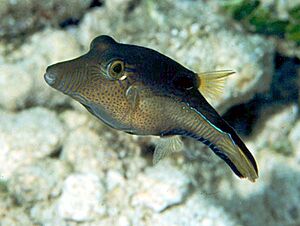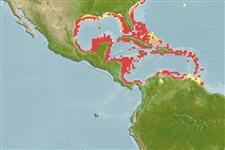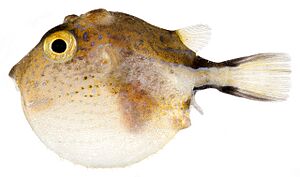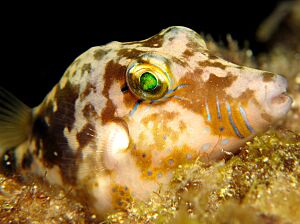Caribbean sharp-nose puffer facts for kids
Quick facts for kids Caribbean sharp-nose puffer |
|
|---|---|
 |
|
| Conservation status | |
| Scientific classification | |
| Genus: |
Canthigaster
|
| Species: |
rostrata
|
The Caribbean sharp-nose puffer (Canthigaster rostrata) is a small pufferfish. It lives in the western central Atlantic Ocean. This fish is about 12 cm (4.7 inches) long when fully grown. You can find it from South Carolina down to Venezuela. It also lives around Bermuda, in the Gulf of Mexico, and throughout the Caribbean Sea.
These puffers can live up to 10 years in the wild. Female puffers often live longer than males. This is because male puffers can be very territorial. The Caribbean sharp-nose puffer is a very poisonous fish. It has special toxins (poisons) in its body, like tetrodotoxin. Even though it's poisonous, some people keep these puffers in aquariums.
Contents
What's in a Name?
The scientific name for this fish is Canthigaster rostrata. This name comes from Latin words. "Gaster" means belly or stomach. "Rostrata" means beaked. This name describes its body shape.
In Mexico, people call this fish "tamborín narizón." This means "big-nosed tambourine." It's a fun name that fits its pointed snout and round body.
About This Pufferfish
The Caribbean sharp-nose puffer belongs to a group of fish called Canthigaster. These puffers are special because they have a unique pointed snout, like a "sharp nose."
How to Spot One
This pufferfish is small, about the size of a softball. Its body is usually white. The top part of its body is a darker brown. It has bright blue spots all over. Its tail fin is yellow with a dark line around the edge.
How It Swims
Like most puffers, the Caribbean sharp-nose puffer is a slow swimmer. Its body is not smooth or streamlined. Instead, it's boxy. It moves by wiggling its top and bottom fins. These fins push the fish forward through the water. Its side fins help it steer and slow down.
Where They Live
You can find the Caribbean sharp-nose puffer from South Carolina all the way to the southern Caribbean. They usually live in water less than 40 meters (130 feet) deep. But they can go as deep as 90 meters (300 feet).
They love to live in coral reefs. You might also see them in seagrass beds and other shallow ocean areas. Male puffers claim large areas of the reef as their territory. These territories can include the smaller territories of one to six females. The male can then mate with the females in his area. Some smaller males don't have a territory and just wander around.
These puffers are common in the Western Atlantic. However, their numbers are slowly going down. This is mainly because coral reefs are being lost.
How They Protect Themselves
Since the Caribbean sharp-nose puffer swims slowly, it needs good ways to stay safe from predators. It has several cool defense tricks.
Puffing Up
One amazing defense is its ability to puff up. When a puffer feels threatened, it quickly gulps water. Its stomach can expand a lot, making the fish up to three times its normal size! This makes it too big for most predators to swallow. Puffers can do this because they don't have ribs, which allows their bodies to stretch.
Spiny Skin
Unlike many fish, the Caribbean sharp-nose puffer doesn't have scales. Instead, its skin is covered in tiny spines. These are called dermal spinules. These spines make the puffer a tough meal for any animal trying to eat it. The spines are all over its body, but they are thickest on its belly.
Dangerous Toxins
The Caribbean sharp-nose puffer is also very poisonous. It has dangerous toxins in its body, like Tetrodotoxin and Saxitoxin. These toxins make the fish deadly to eat. Saxitoxin is a type of poison that can affect nerves. It's thought to come from tiny ocean plants called dinoflagellates. Small animals like shrimp eat these plants. Then, the puffer eats the shrimp, and the toxin builds up in the puffer's body. This is called Bioaccumulation.
Sometimes, sea turtles eat these puffers. High amounts of saxitoxin have been found in the stomachs of sea turtles that have died.
Who Eats Them?
Not many animals can get past the puffer's defenses. So, the Caribbean sharp-nose puffer is not a common meal for most ocean predators. When they are eaten, it's usually by chance. Some animals that have been seen eating this puffer include the great barracuda and the red lionfish. Parts of Caribbean sharp-nose puffers have also been found in the stomachs of green sea turtles.
What They Eat
The Caribbean sharp-nose puffer is an omnivore. This means it eats both plants and animals. A lot of its diet includes plants and sponges. They also eat seagrasses and algae. For animal food, they munch on worms, shrimp, crabs, snails (gastropods), soft coral, sea-stars, sea-cucumbers, and urchins.
Mating and Babies
Caribbean sharp-nose puffers lay eggs. This means the female lays eggs, and the babies grow outside her body. They usually mate in the spring. Most egg-laying happens at dawn.
To mate, a male puffer swims into a female's territory. He performs a display by spreading his fins. If the female is interested, she will show a spotted color pattern. This is a sign that she is ready to mate.
The female releases a group of eggs onto the sand or into a nest made of algae. This usually happens in a seagrass bed. The male then fertilizes the eggs outside her body. The eggs are clear and round.
This species is polygynous. This means one male mates with several females. He mates with the females that live in his territory. While the eggs are growing, the female protects them in her territory. After the eggs hatch, neither parent takes care of the baby puffers.
How They Interact
Male Caribbean sharp-nose puffers are very territorial. If a puffer enters another male's territory, it will flatten itself. It will also show a spotted color pattern. This is a sign that it is giving up.
If a male puffer sees another male in his territory, he will puff up to look bigger. He will spread his fins and tilt his body forward. If these warnings don't work, he will swim in circles and try to bite the other fish. Smaller males often don't have a territory and are known as "wanderers."
Images for kids









